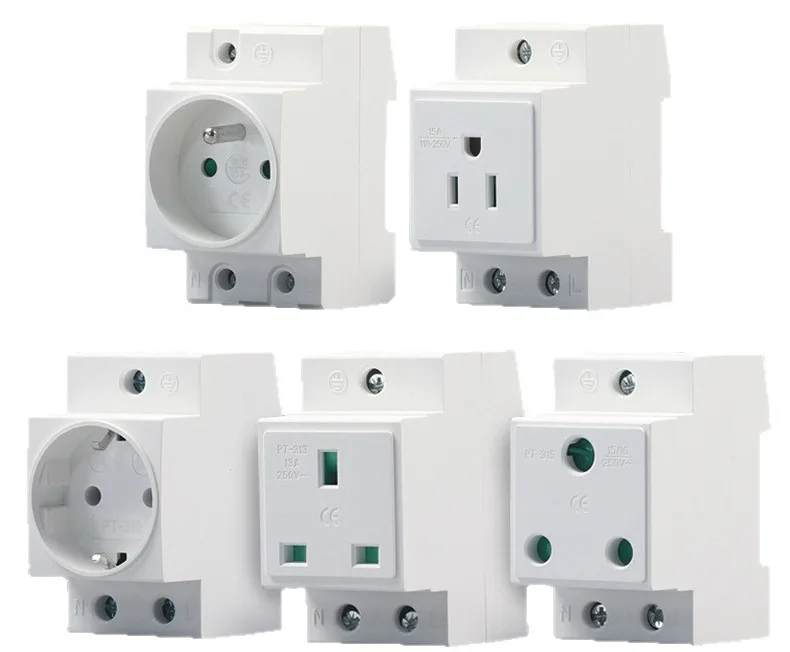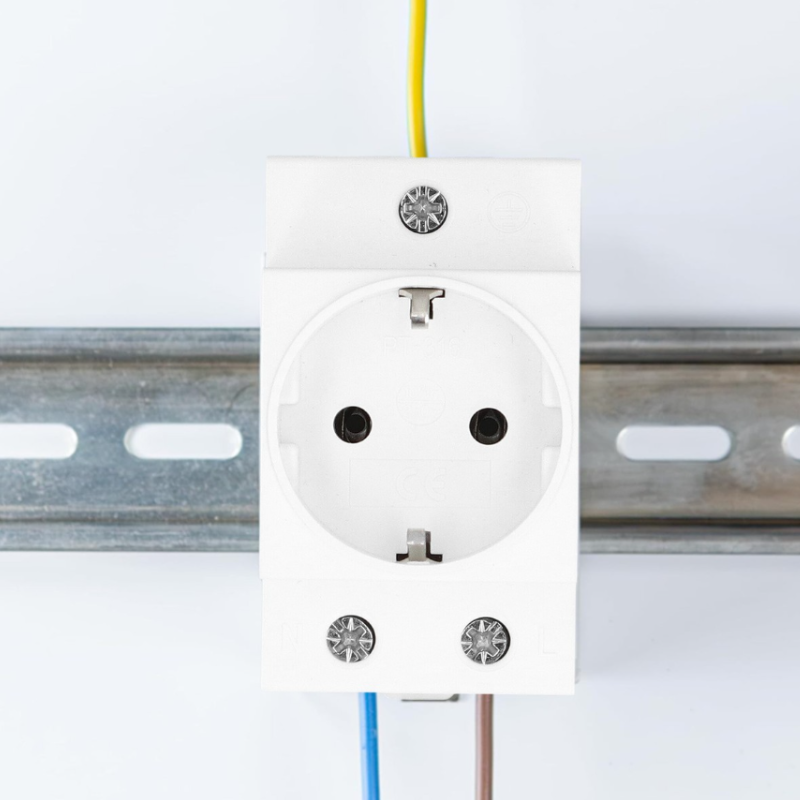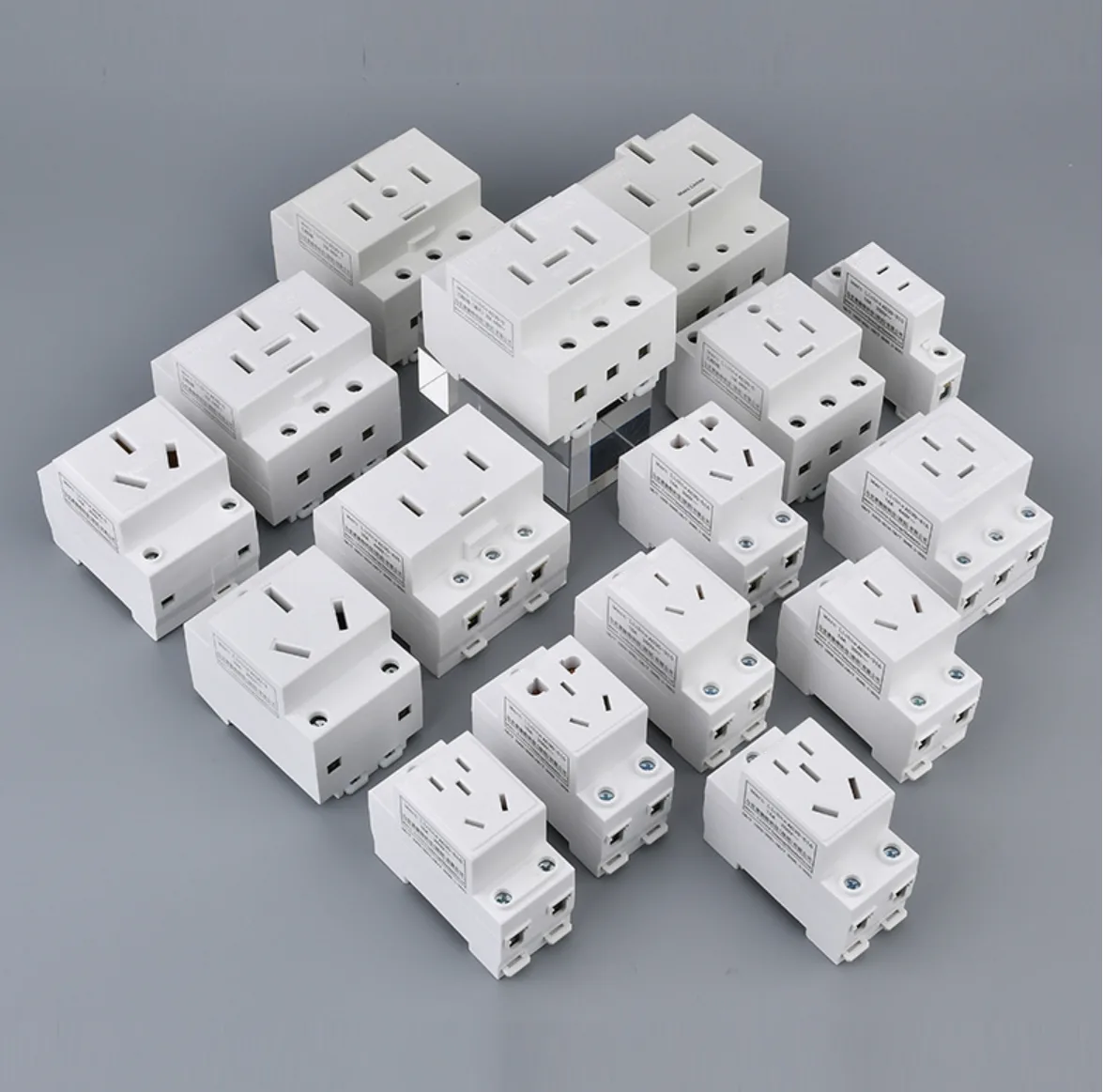In the realm of electrical installations, particularly within industrial control panels, automation systems, and distribution boards, the DIN rail socket stands as a fundamental component that enhances functionality and safety. These specialized electrical outlets are designed to mount directly onto standardized DIN rails, providing convenient power access within electrical enclosures. For anyone working with or designing electrical systems, understanding what a DIN rail socket is and how it works is key to efficient and safe power management.
Bottom Line: A DIN rail socket is an industrial-grade electrical outlet that mounts directly onto standardized DIN rails, providing convenient, accessible power points within control panels and electrical enclosures while maintaining modular design and enhanced safety features.
Understanding the Basics: What Exactly is a DIN Rail Socket?

At its core, a DIN rail socket (also often referred to as a DIN rail mounted outlet or industrial electrical socket) is an electrical power outlet specifically designed to be quickly and securely mounted onto a standardized DIN rail. These rails, typically the 35mm “top-hat” type (as per EN 50022), allow for the neat arrangement of components like circuit breakers, relays, terminal blocks, and power outlets.
The primary purpose is to provide plug presence in electric boards and easy cabling, eliminating the need for running temporary extension cords or complex wiring for devices that require power within the panel itself. These modular sockets allow the connection of devices, tools or electrical and electronic non modular equipment in civil and industrial electrical switchboards.
How DIN Rail Sockets Work
Unlike standard wall outlets, DIN rail sockets are engineered specifically for industrial applications where space optimization and modular flexibility are paramount. The socket housing clips securely onto the DIN rail through a spring-loaded mechanism, creating both mechanical support and electrical connection points.
Key operational features include:
- Snap-on Mounting: Quick attachment to standard 35mm DIN rails
- Secure Connection: Spring-loaded clips ensure stable mounting
- Electrical Integration: Input terminals for power supply with output socket for device connections
- Safety Grounding: Proper earth connections for personnel protection
Why Use a DIN Rail Socket? Key Benefits and Advantages
Integrating DIN rail sockets into your electrical designs offers a multitude of advantages, contributing to more efficient, safer, and better-organized systems. Here’s the thing: their benefits extend beyond simple power provision.
Space Efficiency and Organization
DIN rail sockets are compact and designed to fit seamlessly alongside other DIN rail-mounted components. This modularity contributes significantly to a clean, organized, and professional-looking panel layout. By maximizing the use of available space within an enclosure, engineers can often design more compact and cost-effective panels.
Ease of Installation and Maintenance
One of the standout benefits is the ease of installing DIN rail socket units. Most feature a simple snap-on or clip-on mechanism that allows them to be attached to the DIN rail in seconds, without the need for drilling or special tools. This also means that replacing a faulty socket or adding new ones is a quick and straightforward process, minimizing downtime during maintenance or upgrades.
Enhanced Safety Features
Well-designed DIN rail sockets often incorporate safety features such as:
- Integrated Shutters: Prevent accidental contact with live parts
- Proper Grounding: Ensure electrical safety compliance
- Fuse Protection: Built-in overcurrent protection (typically 6.3A limiting fuses)
- LED Indicators: Visual confirmation of power presence
- GFCI Protection: Ground fault circuit interruption for enhanced safety
Convenience for Service and Diagnostics
Imagine this: a technician needs to service a control panel. Instead of searching for an external power outlet, a control panel socket mounted on the DIN rail provides immediate power for diagnostic tools, laptops for programming, or temporary lighting. This convenience significantly speeds up maintenance and troubleshooting tasks.
Types of DIN Rail Sockets: A Look at Common Variations
DIN rail sockets are not a one-size-fits-all component. They come in various forms to cater to different international standards, functional requirements, and specific needs.
Based on Socket Standards (Country-Specific)
Due to varying electrical standards worldwide, DIN rail sockets are available in multiple configurations:
European Standards:
- Schuko (CEE 7/3 & CEE 7/4): Widely used in Germany and many other European countries
- French/Belgian type (CEE 7/5 & CEE 7/6): Features a prominent earth pin
- BS 1363: The standard UK 3-pin socket
International Standards:
- NEMA (e.g., NEMA 5-15R): The standard for North America (USA, Canada, Mexico)
- Italian, Swiss, Danish: Specific designs for these regions
- Australian/NZ, Indian: Regional-specific configurations
- Universal/Multi-standard Sockets: Designed to accept various plug types
Understanding different country standards for DIN rail sockets is vital for international applications, with voltage ratings typically ranging from 110-120V AC to 220-240V AC and current ratings from 10A to 20A.
Functional Variations
Beyond the basic plug type, DIN rail sockets can include additional features:
Standard Features:
- Basic Power Outlets: Simple, reliable power provision
- Sockets with Integrated Switches: Allow direct on/off control at the unit
- LED Indicator Sockets: Visual confirmation of power status
Advanced Features:
- USB Charging Ports: Modern convenience for electronic devices used during maintenance
- Surge Protection: Built-in protection against voltage spikes
- GFCI/RCD Protected Sockets: Enhanced personnel safety against electric shock
Based on Physical Configuration
Single vs Multiple Outlets:
- Single Outlets: Most common type, providing one power connection
- Double or Multiple Outlets: Multiple connection points from a single DIN rail unit
Module Width Options:
DIN rail components are measured in “modules” (typically 17.5mm or 18mm per module), with sockets available in various widths to fit different space requirements.
Common Applications of DIN Rail Sockets
The versatility of DIN rail socket applications makes them indispensable in a wide range of fields:
Industrial Applications
Control Panel Integration:
Whether in manufacturing plants, automation systems, control panels, or any industrial setting, these sockets seamlessly integrate into diverse environments.
- PLCs and Controllers: Direct power for programmable logic controllers
- HMI Systems: Power supply for human-machine interfaces
- Network Equipment: Supporting switches, modems, and communication devices
- Cooling Systems: Power for small fans and ventilation equipment
Commercial and Building Systems
Building Automation:
- HVAC Control: Power for environmental control systems
- Lighting Control: Supporting automated lighting modules
- Security Systems: Power supply for access control and monitoring equipment
- Energy Management: Supporting smart building technologies
Specialized Applications
Service and Maintenance:
It provides a power supply for electrical tools or instruments during installation, operation and maintenance. This includes:
- Diagnostic Equipment: Power for testing instruments and meters
- Programming Tools: Supporting laptops and handheld programming devices
- Temporary Lighting: Convenient power for work lights during service
- Power Tools: Direct access for maintenance equipment
How to Choose the Right DIN Rail Socket
Selecting the appropriate DIN rail socket requires consideration of several factors to ensure safety, compatibility, and functionality:
Electrical Requirements
Voltage and Current Specifications:
- Ensure socket rating matches local power supply standards
- Consider peak current demands of connected equipment
- Account for future expansion needs
- Verify compatibility with existing electrical infrastructure
Environmental Considerations
Operating Conditions:
Built to withstand harsh industrial environments, vibrations, and varying temperatures, ensuring long-term, reliable performance.
Critical factors include:
- Temperature Range: Operating limits for your environment
- Humidity Exposure: Moisture resistance requirements
- Vibration Tolerance: Mechanical stress considerations
- Chemical Resistance: Protection against corrosive substances
- IP Rating: Dust and water ingress protection when required
Space and Mounting Requirements
Physical Constraints:
- Available Rail Space: Measured in standard module widths
- Clearance Requirements: Space for plug insertion and removal
- Cable Management: Routing and strain relief considerations
- Access Needs: Maintenance and service accessibility
Safety and Compliance
Certification Requirements:
Look for relevant certifications and standards:
- UL Listing: For North American applications
- CE Marking: European compliance
- VDE Certification: German electrical safety standards
- Regional Standards: Local electrical code compliance
Knowing how to choose a DIN rail socket appropriately will prevent compatibility issues and ensure safe operation.
Installation Guide: Installing a DIN Rail Socket
While specific instructions may vary by manufacturer, the general process of installing a DIN rail socket is straightforward. But wait—there’s more to it than just snapping it on!
Pre-Installation Safety
Critical Safety Steps:
- Power Isolation: Disconnect and lock out main power supply
- Verification: Confirm power-off status with appropriate testing equipment
- Documentation: Review electrical drawings and specifications
- Tool Preparation: Gather necessary installation tools and materials
Step-by-Step Installation
1. Mechanical Mounting:
- Position the socket onto the DIN rail
- Hook one edge onto the rail and press until it clicks securely
- Verify secure mounting by gently testing for movement
- Install end stops if required to prevent sliding
2. Electrical Connections:
- Connect Line/Live, Neutral, and Ground/Earth wires to appropriate terminals
- Ensure wire gauge matches socket current rating
- Tighten connections to manufacturer specifications
- Verify all connections are secure to prevent overheating
3. Testing and Verification:
- Restore power following proper safety procedures
- Test socket functionality with appropriate equipment
- Verify LED indicators show proper status (if equipped)
- Test GFCI function where applicable
- Document installation and create proper labeling
Always refer to the manufacturer’s installation guide for specific instructions and safety warnings.
Maintenance and Troubleshooting
Regular Maintenance Procedures
Routine Inspections:
- Monthly: Check terminal connections, LED status, housing condition
- Quarterly: Test GFCI function, verify grounding continuity
- Annually: Tighten all connections, clean contacts, update documentation
Common Issues and Solutions
Power-Related Problems:
- Check fuse status and replace if necessary
- Verify input voltage at terminals
- Inspect connections for looseness or corrosion
- Test continuity through the socket circuit
Physical Issues:
- Inspect housing for impact damage or wear
- Verify DIN rail mounting security
- Check plug retention mechanism function
- Replace damaged components immediately
The Future of DIN Rail Sockets: Trends and Innovations
The humble DIN rail socket continues to evolve with advancing technology:
Smart Integration Features
Emerging Technologies:
- IoT Connectivity: Remote monitoring and control capabilities
- Energy Monitoring: Built-in power measurement and reporting
- Predictive Maintenance: Sensors for condition monitoring
- Digital Communication: Integration with building management systems
Enhanced Design Improvements
Innovation Areas:
- Compact Designs: More functionality in smaller form factors
- Multifunctionality: Combining AC power with DC outputs and data connections
- Advanced Safety: Enhanced protection mechanisms and diagnostic capabilities
- Cybersecurity: Protection for connected smart devices
Industry Standards and Compliance
International Standards
Key Standards:
- EN 60715: European standard for DIN rail dimensions
- IEC 60715: International mounting rail standards
- UL 508: US industrial control equipment standards
- EN 60884: European socket outlet standards
Regional Compliance
Certification Requirements:
Different markets require specific approvals and markings to ensure safety and legal compliance for commercial installation and use.
Conclusion: DIN Rail Sockets – Essential Components for Modern Electrical Systems
In conclusion, the DIN rail socket is far more than just an outlet; it’s a critical component that brings convenience, safety, and efficiency to modern electrical and automation systems. Its standardized mounting, variety of types, and ease of use make it an indispensable element in control panels, distribution boards, and machinery across numerous industries.
These sockets stand out as essential elements in facilitating power distribution and connections within industrial setups. By understanding their benefits and selecting the appropriate type for your needs, you can significantly enhance the functionality, serviceability, and safety of your electrical installations.
Key Takeaways:
- DIN rail sockets provide modular, industrial-grade power access within electrical enclosures
- Proper selection requires considering electrical, environmental, and space requirements
- Installation follows standard electrical practices with DIN rail-specific mounting procedures
- Regular maintenance ensures continued safe and reliable operation
- Future technologies will add smart features while maintaining core functionality
Whether you are providing a DIN rail socket for service purposes or for powering essential in-panel devices, their role in a well-designed system cannot be overstated. So, next time you look inside an electrical panel, appreciate the small but mighty DIN rail socket and the organized power it provides!
For optimal results, always consult with qualified electrical professionals and follow manufacturer guidelines specific to your application and local electrical codes.




